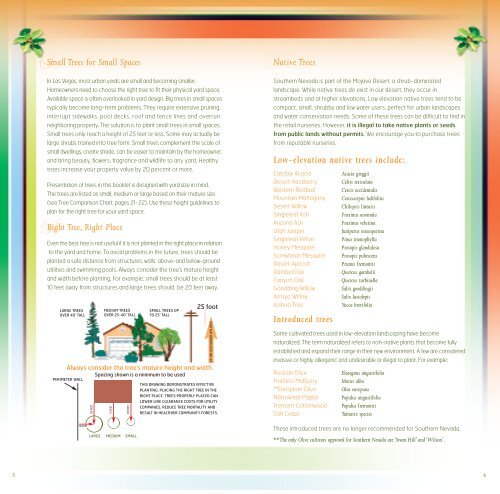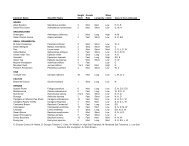trees for Tomorrow.pdf - Nevada Division of Forestry
trees for Tomorrow.pdf - Nevada Division of Forestry
trees for Tomorrow.pdf - Nevada Division of Forestry
Create successful ePaper yourself
Turn your PDF publications into a flip-book with our unique Google optimized e-Paper software.
S<br />
Small Trees <strong>for</strong> Small Spaces<br />
In Las Vegas, most urban yards are small and becoming smaller.<br />
Homeowners need to choose the right tree to fit their physical yard space.<br />
Available space is <strong>of</strong>ten overlooked in yard design. Big <strong>trees</strong> in small spaces<br />
typically become long-term problems. They require extensive pruning,<br />
interrupt sidewalks, pool decks, ro<strong>of</strong> and fence lines and overrun<br />
neighboring property. The solution is to plant small <strong>trees</strong> in small spaces.<br />
Small <strong>trees</strong> only reach a height <strong>of</strong> 25 feet or less. Some may actually be<br />
large shrubs trained into tree <strong>for</strong>m. Small <strong>trees</strong> complement the scale <strong>of</strong><br />
small dwellings, create shade, can be easier to maintain by the homeowner,<br />
and bring beauty, flowers, fragrance and wildlife to any yard. Healthy<br />
<strong>trees</strong> increase your property value by 20 percent or more.<br />
Presentation <strong>of</strong> <strong>trees</strong> in this booklet is designed with yard size in mind.<br />
The <strong>trees</strong> are listed as small, medium or large based on their mature size<br />
(see Tree Comparison Chart, pages 21-22). Use these height guidelines to<br />
plan <strong>for</strong> the right tree <strong>for</strong> your yard space.<br />
R<br />
Right Tree, Right Place<br />
Even the best tree is not useful if it is not planted in the right place in relation<br />
to the yard and home. To avoid problems in the future, <strong>trees</strong> should be<br />
planted a safe distance from structures, walls, above-and below-ground<br />
utilities and swimming pools. Always consider the tree’s mature height<br />
and width be<strong>for</strong>e planting. For example, small <strong>trees</strong> should be at least<br />
10 feet away from structures and large <strong>trees</strong> should be 20 feet away.<br />
LARGE TREES<br />
OVER 40’ TALL<br />
25 foot<br />
Always consider the tree’s mature height and width.<br />
Spacing shown is a minimum to be used<br />
PERIMETER WALL<br />
20 FEET<br />
20 FEET<br />
MEDIUM TREES<br />
OVER 25-40’ TALL<br />
13 FEET<br />
10 FEET<br />
LARGE MEDIUM SMALL<br />
SMALL TREES UP<br />
TO 25’ TALL<br />
25’ OR LESS UNDER UTILITIES.<br />
THIS DRAWING DEMONSTRATES EFFECTIVE<br />
PLANTING, PLACING THE RIGHT TREE IN THE<br />
RIGHT PLACE. TREES PROPERLY PLACED CAN<br />
LOWER LINE CLEARANCE COSTS FOR UTILITY<br />
COMPANIES, REDUCE TREE MORTALITY AND<br />
RESULT IN HEALTHIER COMMUNITY FORESTS.<br />
N<br />
Native Trees<br />
Southern <strong>Nevada</strong> is part <strong>of</strong> the Mojave Desert, a shrub-dominated<br />
landscape. While native <strong>trees</strong> do exist in our desert, they occur in<br />
streambeds and at higher elevations. Low elevation native <strong>trees</strong> tend to be<br />
compact, small, shrubby and low water users, perfect <strong>for</strong> urban landscapes<br />
and water conservation needs. Some <strong>of</strong> these <strong>trees</strong> can be difficult to find in<br />
the retail nurseries. However, it is illegal to take native plants or seeds<br />
from public lands without permits. We encourage you to purchase <strong>trees</strong><br />
from reputable nurseries.<br />
Low-elevation native <strong>trees</strong> include:<br />
Catclaw Acacia Acacia greggii<br />
Desert Hackberry Celtis reticulata<br />
Western Redbud Cercis occidentalis<br />
Mountain Mahogany Cercocarpus ledifolius<br />
Desert Willow Chilopsis linearis<br />
Singleleaf Ash Fraxinus anomala<br />
Arizona Ash Fraxinus velutina<br />
Utah Juniper Juniperus osteosperma<br />
Singleleaf Piñon Pinus monophylla<br />
Honey Mesquite Prosopis glandulosa<br />
Screwbean Mesquite Prosopis pubescens<br />
Desert Apricot Prunus fremontii<br />
Gambel Oak Quercus gambelii<br />
Canyon Oak Quercus turbinella<br />
Goodding Willow Salix gooddingii<br />
Arroyo Willow Salix lasiolepis<br />
Joshua Tree Yucca brevifolia<br />
Introduced <strong>trees</strong><br />
Some cultivated <strong>trees</strong> used in low-elevation landscaping have become<br />
naturalized. The term naturalized refers to non-native plants that become fully<br />
established and expand their range in their new environment. A few are considered<br />
invasive or highly allergenic and undesirable or illegal to plant. For example:<br />
Russian Olive Eleaegnus angustifolia<br />
Fruitless Mulberry Morus alba<br />
**European Olive Olea europaea<br />
Narrowleaf Poplar Populus angustifolia<br />
Fremont Cottonwood Populus fremontii<br />
Salt Cedar Tamarix species<br />
These introduced <strong>trees</strong> are no longer recommended <strong>for</strong> Southern <strong>Nevada</strong>.<br />
**The only Olive cultivars approved <strong>for</strong> Southern <strong>Nevada</strong> are ‘Swan Hill’ and ‘Wilson’.<br />
5 6



